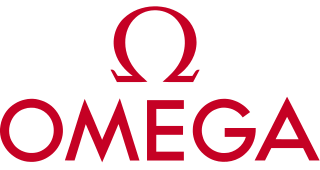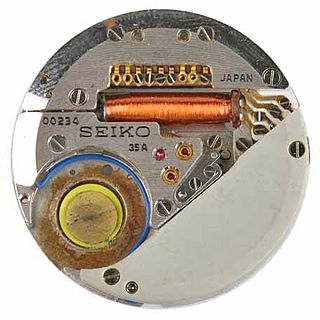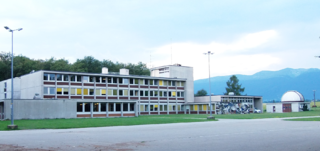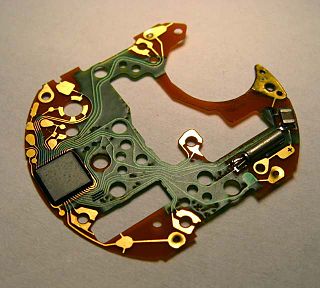
A watch is a portable timepiece intended to be carried or worn by a person. It is designed to keep a consistent movement despite the motions caused by the person's activities. A wristwatch is designed to be worn around the wrist, attached by a watch strap or other type of bracelet, including metal bands, leather straps, or any other kind of bracelet. A pocket watch is designed for a person to carry in a pocket, often attached to a chain.

Seiko Group Corporation, commonly known as Seiko, is a Japanese maker of watches, clocks, electronic devices, semiconductors, jewelry, and optical products. Founded in 1881 by Kintarō Hattori in Tokyo, Seiko introduced the world's first commercial quartz wristwatch in 1969.

Omega SA is a Swiss luxury watchmaker based in Biel/Bienne, Switzerland. Founded by Louis Brandt in La Chaux-de-Fonds in 1903, the company formerly operated as La Generale Watch Co. until incorporating the name Omega in 1903, becoming Louis Brandt et Frère-Omega Watch & Co. In 1984, the company officially changed its name to Omega SA and opened its museum in Biel/Bienne to the public. Omega is a subsidiary of The Swatch Group.

The Contrôle officiel suisse des Chronomètres (COSC), the Official Swiss Chronometer Testing Institute, is the institute responsible for certifying the accuracy and precision of Swiss watches.

Zenith SA is a Swiss luxury watchmaker. The company was started in 1865 by Georges Favre-Jacot in Le Locle in the canton of Neuchâtel and is one of the oldest continuously operating watchmakers. Favre-Jacot invented the concept of "in house movements", believing that only through control of the entire watchmaking process could the highest quality be achieved. Zenith was purchased by LVMH in November 1999, becoming one of several brands in its watch and jewellery division, which includes TAG Heuer and Hublot. Julien Tornare is president and CEO.

In horology, a tourbillon is an addition to the mechanics of a watch escapement to increase accuracy, it was developed by the Swiss-French watchmaker Abraham-Louis Breguet and patented by Breguet on 26 June 1801. In a tourbillon the escapement and balance wheel are mounted in a rotating cage, with the goal of eliminating errors of poise in the balance giving a uniform weight.

The Besançon Astronomical Observatory is an astronomical observatory owned and operated by the Centre national de la recherche scientifique. It is located in Besançon, France.

The Neuchâtel Observatory is an astronomical observatory funded by the Public Economy Department of the canton of Neuchâtel, Switzerland. It is located in the city of Neuchâtel and was founded in 1858. The first director was the 71 year old German astronomer Adolphe Hirsche.

A marine chronometer is a precision timepiece that is carried on a ship and employed in the determination of the ship's position by celestial navigation. It is used to determine longitude by comparing Greenwich Mean Time (GMT), and the time at the current location found from observations of celestial bodies. When first developed in the 18th century, it was a major technical achievement, as accurate knowledge of the time over a long sea voyage was vital for effective navigation, lacking electronic or communications aids. The first true chronometer was the life work of one man, John Harrison, spanning 31 years of persistent experimentation and testing that revolutionized naval navigation.

A chronometer is an extraordinarily accurate mechanical timepiece, with an original focus on the needs of maritime navigation. In Switzerland, timepieces certified by the Contrôle Officiel Suisse des Chronomètres (COSC) may be marked as Certified Chronometer or Officially Certified Chronometer. Outside Switzerland, equivalent bodies, such as the Japan Chronometer Inspection Institute, have in the past certified timepieces to similar standards, although use of the term has not always been strictly controlled.

The quartz crisis was the upheaval in the watchmaking industry caused by the advent of quartz watches in the 1970s and early 1980s, that largely replaced mechanical watches around the world. It caused a significant decline of the Swiss watchmaking industry, which chose to remain focused on traditional mechanical watches, while the majority of the world's watch production shifted to Japanese companies such as Seiko, Citizen, and Casio which embraced the new electronic technology.

The King's Observatory is a Grade I listed building in Richmond, London. Now a private dwelling, it formerly housed an astronomical and terrestrial magnetic observatory founded by King George III. The architect was Sir William Chambers; his design of the King's Observatory influenced the architecture of two Irish observatories – Armagh Observatory and Dunsink Observatory near Dublin.

The Geneva Observatory is an astronomical observatory at Sauverny (CH) in the municipality of Versoix, Canton of Geneva, in Switzerland. It shares its buildings with the astronomy department of the École Polytechnique Fédérale de Lausanne. It has been active in discovering exoplanets, in stellar photometry, modelling stellar evolution, and has been involved in the European Space Agency's Hipparcos, INTEGRAL, Gaia, and Planck missions.
Léon Louis Gallet (1832–1899), watchmaker, entrepreneur, philanthropist, and past family patriarch of the Gallet Watch Company of Switzerland, is considered as one of the primary architects and founders of the 19th century industrialization of the Swiss watchmaking industry.

Gallet (ˈgæl.eɪ) is a historic Swiss manufacturer of high-end timepieces for professional, military, sports, racing, and aviation use. Gallet is the world's oldest clock making house with history dating back to Humbertus Gallet, a clock maker who became a citizen of Geneva in 1466. The Gallet & Cie name was officially registered by Julien Gallet (1806–1849) in 1826, who moved the family business from Geneva to La Chaux-de-Fonds, Switzerland. Prior to this date, operations commenced under the name of each of the Gallet family patriarchs.

Quartz clocks and quartz watches are timepieces that use an electronic oscillator regulated by a quartz crystal to keep time. This crystal oscillator creates a signal with very precise frequency, so that quartz clocks and watches are at least an order of magnitude more accurate than mechanical clocks. Generally, some form of digital logic counts the cycles of this signal and provides a numerical time display, usually in units of hours, minutes, and seconds.

The Omega Marine Chronometer was the first quartz wristwatch ever to be awarded certified status as a marine chronometer. The watch was made by Omega SA and developed by John Othenin-Girard and is one of the most accurate non thermo-compensated production watches ever made, keeping time to within 1 second per month















